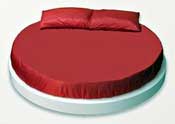Waterbeds
Over 45 years ago, I was married and we traveled the State of California for a week during our honeymoon. One of the hotels we stayed at had a waterbed. All it took was one night and my wife was sold on the idea of waterbeds. So a year or two later we went shopping for a waterbed and have been sleeping on them ever since. It is probably one of the reasons why I never experience back pains. They conform to the body and because they are heated, it is so comfortable on a cold winter night. There is one other secret about waterbeds, babies love them. When our children came along and you try to put them to bed and they are fussy, all we would do is put them on the warm waterbed for a few minutes and they were fast asleep.
Waterbeds were a fad 50 years ago which has almost completely disappeared in today's world. They are very heavy. So some apartment managers refused to allow them because the added weight might over-stress the carrying capacity of the floor. AND THE FLOOR WOULD COLLAPSE INTO THE APARTMENT BELOW. I never experience that problem but I could imagine that substandard construction does exist. The other problem is the inconvenience of running water hoses into the bedroom from the outside to fill or drain a waterbed. They will spring a leak every now and then. Over the 45 years we had them, this happened 4 or 5 times. In most cases we drained the waterbed, fixed the leak, and then refilled it and then we were good to go.
What spurred this discussion. Well I came across an article this morning called
What Ever Happened To Waterbeds?
Here is some excerpts:
For kids and adults alike, waterbeds used to be the coolest—until suddenly they weren’t. After a heyday in the late 1980s in which nearly one out of every four mattresses sold was a waterbed mattress, the industry dried up in the 1990s, leaving behind a sense of unfilled promise and thousands upon thousands of unsold vinyl shells. In 2016, waterbeds make up only a very small fraction of overall bed and mattress sales. Many home furnishing retailers won’t sell them, and some that do say it’s been years since they last closed a deal.
The inventor of the modern day waterbed was an industrial design student named Charles Hall, who in 1968 submitted a waterbed prototype (made with a vinyl mattress rather than a rubber one) for his masters thesis project. Hall wanted to rethink furniture design, and was taken with the idea of fluid-filled interiors. Before settling on the waterbed, he had tried filling a chair with 300 pounds of cornstarch gel, which quickly rotted. He also tried using JELL-O as a filling, with similarly disastrous results. The introduction of water fulfilled his vision without the ick factor. During the graduating class’s thesis workshop, Hall told The Atlantic, students ignored other projects and ended up hanging out on his waterbed.
Hall established his own company, Innerspace Environments, and began manufacturing waterbeds for sale throughout California. Early customers included the band Jefferson Airplane, as well as the Smothers Brothers. Eventually Hall’s bed, which he named “The Pleasure Pit,” made its way into 32 retail locations throughout the state. Success was short-lived, however, as cheap imitators quickly flooded the market. By the early 1970s, dozens of different companies were manufacturing waterbeds, feeding the growing demand for a groovy new way to … sleep.
Although many associate waterbeds with strait-laced suburban living, back in the ‘70s they were a symbol of the free-flowing counterculture movement—more likely to be sold with incense and Doors albums than with fluffy pillows and high thread count sheets. “That fluid fixture of 1970s crash pads” was how a New York Times story from 1986 described them. The names of manufacturers and distributors reflected this: Wet Dream, Joyapeutic Aqua Beds, and Aquarius Products were a few that rolled with the times. 
Sex, of course, was a big selling point. “Two things are better on a waterbed,” an Aquarius ad stated. “One of them is sleep.” Another ad proclaimed, “She’ll admire you for your car, she’ll respect you for your position, and she’ll love you for your waterbed.” Hippies and hip bachelors alike were the target market for the bed that promised the motion of the ocean. Hall even got in on the act, offering a $2800 “Pleasure Island” setup, complete with contour pillows, color television, directional lighting, and a bar. Hugh Hefner loved the craze, of course—Hall made him one covered in green velvet, and Hef had another that he outfitted in Tasmanian possum hair.
People were also eager to try a new spin on something as boring as a bed. Kids, especially, loved the squishy, gurgling weirdness of a waterbed. If you were a child of the '80s, it arguably was as close to a status symbol as you could get. Manufacturers, meanwhile, fed the demand with novelty frames, bunk beds, circular love nest beds, and even waterbeds for dogs. They also improved the experience with innovations like “baffles” that cut down on the wave motion many beds created, thereby addressing the one-of-a-kind problem of people getting seasick in their own bedrooms.
Anyways it was a very interesting article and worth the read.
_________________
Author of Practical Preparations for a Coronavirus Pandemic.
A very unique plan. As Dr. Paul Thompson wrote, "This is the very best paper on the virus I have ever seen."






